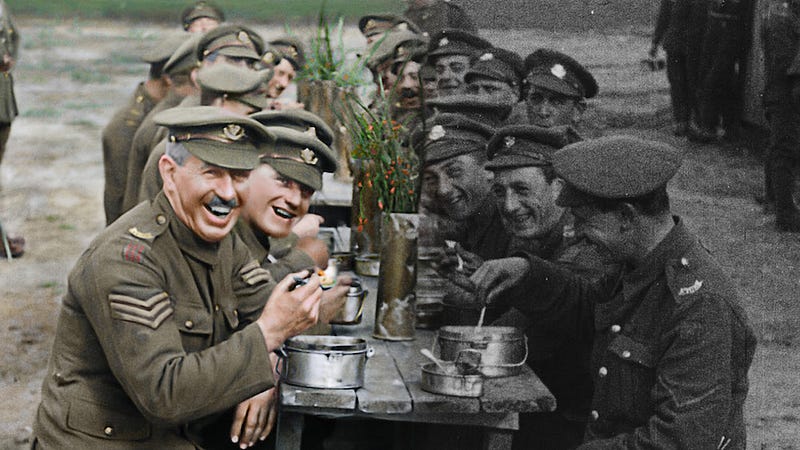A stunning technical achievement and affecting tribute to the British Infantry of the Great War

Over Christmas 2018, Fathom Events unassumingly rolled out They Shall Not Grow Old in limited release across the US. Response was overwhelmingly positive, with cinema goers driving it to a box office take of $8.34 million, making it the highest-grossing U.S. Cinema Event release ever. This was evidence this is a film people want to see on the big screen, prompting a wider re-release this coming weekend, an opportunity that should not be missed.
The documentary was commissioned by 14–18 Now, the UK arts program for the First World War centenary, together with the Imperial War Museum and the BBC, with the intention of marking the centenary of the end of the First World War. They recruited filmmaker Peter Jackson to take the helm of the project, one with a unique approach, to be solely made up of footage from the era. Jackson’s approach was to go above simple restoration of this footage, using new techniques to bring a clarity to the images, but taking things a step further, using colorization and 3D effects and more, to immerse viewers in the life of these men (and boys) in Britain. The film moves through entry to the first World War, recruitment, training, and then the experiences of being thrown onto the front lines of a conflict that claimed the lives of millions.


The film opens with old school footage. It’s film stock that has degraded over time, with detail that was poor to begin with and even worse now. Movements are jerky due to the antiquated technology. These monochrome images, framed as if watched through an old viewfinder, eventually open up, expanding to fill the screen, while color bleeds into the footage. The effect is pretty staggering. Improved detail and clarity is obvious, and a subtle 3D effect draws you in further. Footage of the age, so often shot in very low frames per second due to tech limitations, is corrected to 24fps, our standard today, by somehow filling in the gaps. Movements that once jumped around take on a more natural pace. It seems to add a veneer beyond the superficial, one that ties the footage more to our own time, adding to the truth and potency of what we see. So often technology seems to be draining our films of life, but here we see how it is equally adept at infusing life into it. By opening up this footage in such a natural way, it also made them able to better see what what happening, most notably in terms of lip reading those caught onscreen. Conversations picked up on range from training orders, battle prep, or even a wave and “hello mum” to camera. Snippets of solemn ruminations, mundanity, and good-natured humor counter some of the more visceral moments you’ll see unfold. The film doesn’t hold back in terms of grim imagery later on.
Another creative choice aids the immersion — no actor or celebrity is used to narrate the footage, nor an esteemed historian. Instead Jackson drew from interviews of veterans conducted in the ‘60s and ‘70s, their insights and memories matched to pieces of footage to give an overarching picture of WWI. From the contributions, we have commentary from a range of men of different ages, different social classes, and different ranks within the army. The thing that connects them all is they were brothers in arms, survivors, and had a devotion to the humble cup of tea. We hear tales of their lives before, how they enlisted, the rigors of boot camp training to quickly whip them into shape, and they how they were sent over to France and Belgium. On the front lines, the film puts the human cost of war at the forefront, using these personal, authentic insights to tell the emotional and physical cost of the struggle. We learn how these men cope, and what they lost along the way.
Being commissioned by the Imperial War museum, the focus is on the British infantrymen, although there is some footage and discussion of Russian and German troops towards the end. The focus does give a fine overarching tale of one aspect of the war; but it is just one aspect, which some may find frustrating. But this focus gives it a momentum, an intensity that envelopes you and hurtles you forward alongside these men, building to the big push, the front line movement into no man’s land that came towards the end of the conflict and was when so many lives were lost. It’s in this numbing aftermath that the horrors and cost of war become all the more stark. Like many, I have complained about the practice of taking old film or footage and modernizing it, from Lucas’s warped attempted to ‘improve’ the original Star Wars trilogy to more abhorrent examples. Here the intent feels different, an effort to bring a truth to footage that has lost its natural flow, texture, and in a way, humanity. They Shall Not Grow Old ties these images to our modern era, and in doing so makes them all the more real, serving as a potent reminder of this time and the lasting impact of war.


They Shall Not Grow Old is a stunning technical achievement. What impresses more is how the painstaking techniques are harnessed to not just restore detail and depth to the footage, but humanity too. Pictures and words from the time and from the people are married to a deftly executed technique to deliver an enthralling testament to the experiences of British Infantry during World War I. An indelible viewing experience.

They Shall Not Grow Old rolls out in 500 theaters across 150 markets from February 1st, 2018.


